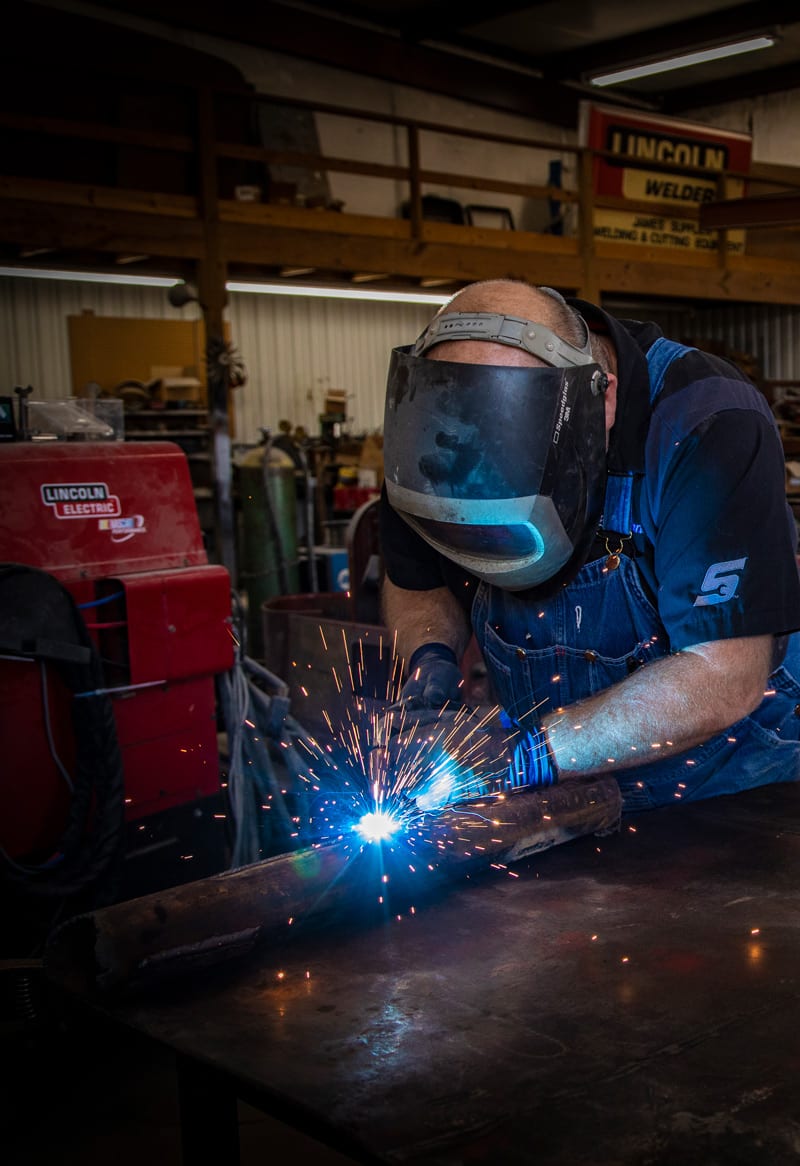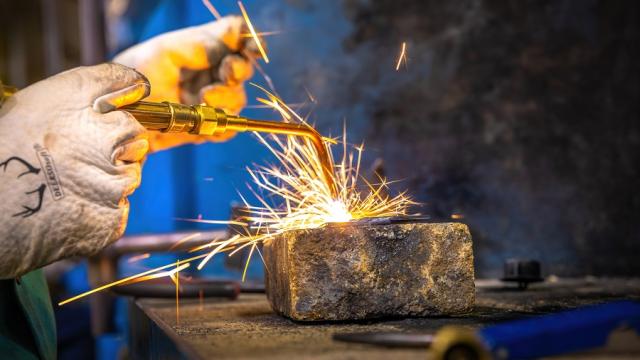All Concerning Welding: Secret Insights Into Techniques and Ideal Practices for Success
Welding incorporates a variety of techniques, each fit for certain products and applications. Comprehending these techniques, such as GMAW, SMAW, and TIG, is crucial for accomplishing perfect results. The appropriate devices and safety and security practices can not be overlooked. As prep work and troubleshooting play critical functions in the welding process, grasping these aspects can greatly enhance the quality of the end product. What are the vital elements that guarantee an effective weld?
Recognizing Different Welding Strategies
Welding strategies include a variety of methods, each suited to specific applications and materials. Amongst one of the most common methods are Gas Metal Arc Welding (GMAW), Shielded Metal Arc Welding (SMAW), and Tungsten Inert Gas Welding (TIG) GMAW, also called MIG welding, is prominent for its speed and convenience, making it perfect for thin materials. SMAW, or stick welding, is preferred for its simpleness and effectiveness in outside atmospheres, specifically with thicker steels. TIG welding supplies accuracy and control, making it suitable for complex job and non-ferrous steels (Montana Mobile Welding and Repair Belgrade Fabrication). Each method has its distinct benefits and considerations, allowing welders to choose the finest technique based upon the project's demands, material type, and desired outcomes. Recognizing these strategies is crucial for effective welding
Vital Welding Equipment and Tools
While numerous welding methods require certain skills, the appropriate equipment and devices are equally vital for attaining high quality outcomes. Important welding equipment includes welding makers, which vary depending upon the strategy-- such as MIG, TIG, or stick welding. Protective equipment, consisting of safety helmets, gloves, and aprons, assurances safety and security and comfort throughout the process. Additionally, clamps and components assist secure products in area, making sure accuracy in welds. Consumables like welding rods, cord, and securing gas are likewise essential components that affect the high quality of the weld. Additionally, tools such as mills and cutters assist in surface area prep work and post-weld finishing, adding to a specialist end result. Buying high-grade devices eventually improves the performance and performance of welding projects.
Security Practices in Welding
Appropriate safety and security practices are essential in the welding market to shield workers from possible threats. Welders must use suitable personal protective devices (PPE), including headgears with correct shading, gloves, and flame-resistant clothing. Appropriate ventilation is important to lower direct exposure to dangerous fumes and gases produced during the welding procedure. Additionally, workers ought to be learnt the proper handling of welding devices to stop mishaps. Fire precaution, such as maintaining flammable products away from the welding location and having fire extinguishers readily available, are necessary. Routine inspections of devices and offices can assist recognize potential dangers before they result in mishaps. By adhering to these safety and security practices, welders can produce a more secure working atmosphere and lessen risks connected with their trade.
Preparing Products for Welding
Preparing materials for welding is a vital action that considerably affects the quality and honesty of the last item (Belgrade). Proper preparation entails cleaning the surfaces to get rid of pollutants such as dirt, corrosion, and oil, which can jeopardize the weld. Techniques such as grinding, sanding, or using solvents are generally employed to achieve a tidy surface area. Additionally, making sure that the products mesh snugly is vital; gaps can result in weak welds. It's likewise important to take into consideration the positioning and positioning of the elements, as this will impact the convenience of welding and the final result. Picking the proper filler product and making certain compatibility with the base metals is essential for accomplishing solid, durable welds.
Tips for Getting High-Quality Welds
Achieving premium welds requires attention to detail and adherence to finest techniques throughout the welding process. Appropriate joint preparation is necessary, ensuring surface areas are clean and cost-free from contaminants. Choosing the appropriate filler material and welding strategy based upon the base steels is essential for optimal bonding. Preserving constant travel speed and angle while welding can protect against problems and advertise uniformity. In addition, controlling heat input is essential; extreme warm can cause warping and deteriorated joints. Consistently inspecting the welds during the process allows for instant modifications if essential. Employing suitable post-weld therapies, such as cleansing and tension alleviation, can improve the durability and honesty of the weld, eventually guaranteeing an effective result.
Repairing Usual Welding Issues
Welding often presents obstacles that can influence the quality and integrity of the last item. Common concerns such as porosity, irregular weld grains, and getting too hot can develop, each needing particular troubleshooting strategies. Comprehending these issues is essential for welders to enhance their skills and attain ideal results.
Porosity Problems Clarified
Although porosity my explanation can often be ignored, it remains an essential concern in welding that can jeopardize the integrity of a finished product. Porosity refers to the existence of tiny gas pockets within the weld bead, which can deteriorate the joint and lead to premature failure. This issue commonly occurs from pollutants, moisture, or improper protecting gas coverage during the welding procedure. To alleviate porosity, welders must verify that the base products are clean and completely dry, use proper shielding gases, and maintain constant welding criteria. Consistently examining the tools and environment can likewise aid identify prospective problems prior to they show up in the weld. Dealing with porosity effectively is important for attaining strong, long lasting welds that satisfy quality requirements.

Irregular Weld Beans
Inconsistent weld beads can greatly impact the quality and strength of an ended up product. Numerous aspects add to this concern, including inappropriate travel rate, incorrect amperage settings, and irregular electrode angles. When the welder moves also rapidly, a grain may show up slim and do not have penetration, while relocating too slowly can create excessive accumulation. Furthermore, using the wrong amperage can cause either undercutting or excessive spatter, both of which concession weld integrity. The welder's method, such as irregular lantern movement, can likewise lead to irregular grain appearance. To alleviate these issues, welders must focus on keeping consistent, regulated movements and making sure appropriate tools settings to attain harmony in their welds. Uniformity is key to achieving strong and trusted welds.
Getting Too Hot and Bending Issues
Too much warm during the welding process can bring about significant overheating and buckling issues, impacting the architectural stability of the work surface. These issues typically materialize as distortion, which can jeopardize placement and fit-up, making more setting up testing. Aspects adding to overheating include the selection of welding parameters, such as voltage and travel rate, find out along with the kind of product being welded. To mitigate these issues, welders need to maintain regular traveling rate and ideal heat input while monitoring the workpiece temperature. Additionally, pre-heating or post-weld heat treatment can assist reduce anxieties triggered by quick air conditioning - Belgrade Welding. Regular evaluation and adherence to finest methods are necessary in preventing getting too hot and guaranteeing the durability and integrity of welded frameworks
Frequently Asked Concerns
What Are the Profession Opportunities in the Welding Market?
The welding sector supplies diverse job opportunities, including positions as welders, assessors, instructors, and engineers. Experts can function in manufacturing, building, aerospace, and automobile fields, gaining from strong demand and competitive wages in different functions.
How Can I Boost My Welding Rate Without Sacrificing Top Quality?
To improve welding speed without sacrificing top quality, one need to practice efficient strategies, keep tools, enhance setups, and enhance hand-eye control. Routine training and looking for comments can additionally significantly add to accomplishing quicker, top quality welds.
What Qualifications Are Offered for Welders?
Countless certifications exist for welders, consisting of those from the American Welding Culture (AWS), precision welding the National Center for Building And Construction Education and Study (NCCER), and different industry-specific companies. These qualifications improve employability and show skill efficiency.
How Does Welding Influence the Qualities of Metals?
Welding affects the properties of metals by changing their microstructure, which can result in changes in toughness, hardness, and ductility. Warm input and cooling prices throughout the procedure greatly influence these material qualities.
Can I Weld Dissimilar Metals With Each Other?
